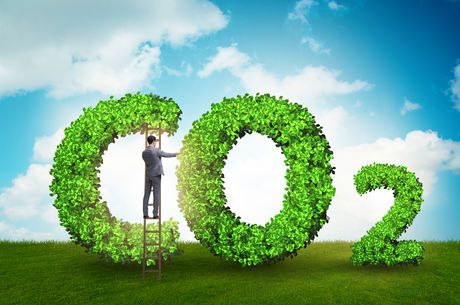
The discount of carbon dioxide (CO2) emissions is a urgent problem in combating local weather change and reaching sustainability. World CO2 emissions have been rising steadily over the previous century, primarily pushed by the consumption of fossil fuels and deforestation. Regardless of efforts to curb emissions, the buildup of greenhouse gases within the ambiance has continued to extend.
Within the context of inns, lowering CO2 emissions includes the aware and deliberate actions taken by these institutions to attenuate their contribution to atmospheric CO2 ranges. Lodges make use of a variety of methods and applied sciences practices to scale back the carbon footprint related to their operations. On this opinion article, the creator mentioned the present state, strengths, weaknesses, and future instructions of CO2 emissions discount within the lodge trade.
Present state
The discount of CO2 emissions by inns is gaining momentum. Lodges are integrating sustainability into operations, specializing in vitality effectivity, renewable vitality, water and waste administration and visitor engagement. Challenges focus on prices and each availability and adoption of sustainable practices. Total, the hospitality trade reveals a dedication to lowering CO2 emissions, however enchancment is required.
Rising Consciousness and Dedication: Lodges are more and more recognizing the significance of sustainability and the necessity to handle their carbon footprint. This shift is pushed by visitor demand, company social obligations, and regulatory necessities.
Vitality Effectivity Measures: Lodges are implementing numerous vitality effectivity measures all through their operations. This consists of upgrading lighting methods to LEDs, optimizing HVAC methods, putting in good controls and sensors, and minimizing vitality consumption. Selling inexperienced initiatives and acquiring eco-certifications have enhanced the popularity and enchantment of inns to a wider viewers.
Renewable Vitality Integration: Adopting renewable vitality is one other essential focus. Some inns are investing in renewable vitality to energy their operations. This may increasingly contain putting in photo voltaic panels, wind generators, or geothermal methods on-site to generate clear and renewable electrical energy. The adoption of renewable vitality helps inns scale back their reliance on fossil fuels and reduce CO2 emissions.
Inexperienced Constructing Certifications: Lodges are pursuing inexperienced constructing certifications corresponding to LEED (Management in Vitality and Environmental Design) or BREEAM (Constructing Analysis Institution Environmental Evaluation Methodology) to exhibit their dedication to sustainability. These certifications assess the environmental efficiency of buildings and supply tips for vitality effectivity, water conservation, waste administration, and indoor environmental high quality.
Water and Waste Administration: Lodges are implementing initiatives corresponding to water-efficient fixtures, water recycling methods, waste discount, recycling packages, and meals waste composting. These efforts not directly contribute to the discount of CO2 emissions by minimizing energy-intensive water remedy processes and lowering methane emissions from landfills.
Visitor Engagement: Lodges are participating visitors in sustainable practices to lift consciousness and encourage habits change. This includes offering data on energy-saving choices, providing towel and linen reuse packages, selling sustainable transportation options, and inspiring accountable useful resource consumption throughout visitors’ stays.
Collaboration and Trade Initiatives: Lodges are collaborating with trade associations, sustainability organizations, and friends to share greatest practices and drive collective motion. They take part in initiatives such because the World Sustainable Tourism Council (GSTC) and hotel-specific sustainability packages to trade data, entry assets, and work in direction of frequent targets.
Strengths and weaknesses
Decreasing CO2 emissions in inns is environmentally, economically, and socially useful. It has strengths and advantages but in addition challenges. Overcoming weaknesses requires strategic approaches, collaboration, useful resource utilization, and long-term dedication to sustainability. Listed below are strengths and weaknesses of lowering CO2 emissions by inns.
Strengths:
Environmental Advantages: Lodges are important vitality shoppers and CO2 contributors as a consequence of their operations, together with air con, lighting, water heating, and laundry companies. Due to this fact, the first good thing about lowering CO2 emissions by inns is the optimistic impression on the atmosphere. By lowering their reliance on fossil fuels, preservation of pure assets, and safety of ecosystems, inns can assist mitigate local weather change and reduce their environmental footprint.
Vitality Price Financial savings: Implementing energy-saving measures and adopting renewable vitality can result in substantial price financial savings for inns. Vitality-efficient applied sciences, corresponding to LED lighting, good thermostats, occupancy sensors, and environment friendly HVAC methods, can scale back electrical energy and gasoline consumption. That discount interprets into decrease utility payments and operational bills, which improves profitability.
Aggressive Benefit: In at this time’s world, visitors are actively looking for out sustainable lodging choices. Lodges that prioritize sustainability can acquire a aggressive edge available in the market by attracting environmentally aware visitors. Selling inexperienced initiatives can appeal to and retain these visitors, resulting in elevated occupancy charges and buyer loyalty.
Regulatory Compliance: Governments and regulatory our bodies worldwide are more and more implementing stricter environmental rules. By proactively lowering emissions, inns can guarantee compliance with these rules, avoiding potential penalties and authorized points.
Model Fame and Company Social Accountability: Embracing emissions discount showcases a lodge’s dedication to company social accountability (CSR) and environmental stewardship. This may improve the lodge’s popularity, appeal to environmentally aware stakeholders, and align with societal expectations for sustainable practices.
Weaknesses:
Technological Limitations: Some inns could face technological limitations when adopting vitality effectivity or renewable vitality. Geographic constraints, architectural limitations, or lack of availabilities of sustainable applied sciences can pose challenges in reaching important emissions reductions.
Habits and Consciousness: The success of emissions discount initiatives in inns usually depends closely on each visitors and employees. Encouraging energy-saving practices, selling sustainable behaviors, and elevating consciousness could require steady effort and engagement to make sure widespread adoption.
Monitoring and Measurement: Measuring and monitoring emissions reductions may be advanced, notably for bigger inns or lodge chains with a number of places. Establishing correct baseline knowledge and implementing sturdy monitoring methods to trace progress may be difficult and require specialised experience and assets.
Future instructions
Future instructions for lowering CO2 emissions from inns are to embrace superior applied sciences, combine sustainable practices, foster collaboration, and align with world sustainability targets. Being adaptable and proactive permits inns to contribute to a sustainable and low-carbon future. Listed below are some key future instructions on this space:
Sustainable Constructing Design and Building: Designing and setting up inns with sustainability in thoughts can considerably scale back vitality consumption and CO2 emissions. Implementing inexperienced constructing practices corresponding to environment friendly insulation, pure lighting, and passive cooling and heating methods can reduce the lodge’s general vitality demand and environmental impression.
Superior Vitality Administration Techniques: Advances in know-how will play a major function in emissions discount. Lodges will more and more undertake superior vitality administration methods that leverage synthetic intelligence (AI), machine studying, and knowledge analytics to optimize vitality consumption and scale back emissions. These methods can mechanically alter HVAC settings, lighting controls, and vitality utilization based mostly on occupancy patterns and environmental situations, resulting in extra exact vitality administration.
Integration of Sensible Constructing Applied sciences: Lodges will more and more combine good constructing applied sciences to boost vitality effectivity additional. The progressive options embrace the usage of sensors, Web of Issues (IoT) gadgets, and automation methods to observe and management energy-consuming tools and methods in real-time. By gathering and analyzing knowledge, inns can establish energy-saving alternatives and enhance operational effectivity.
Decentralized Renewable Vitality Technology: The longer term will witness elevated deployment of decentralized renewable vitality technology in inns. This shift within the integration of renewable vitality permits inns to generate clear vitality on-site, scale back reliance on the grid, and decrease carbon emissions related to electrical energy consumption.
Web-Zero and Carbon Neutrality: The main target will shift in direction of reaching net-zero or carbon-neutral operations. Extra inns will try to stability their remaining emissions by implementing sturdy emissions discount methods and investing in high-impact carbon offset initiatives. It’ll contain steady monitoring, reporting, and verification of emissions to make sure progress in direction of these formidable targets. This dedication aligns with world efforts to restrict world warming and fight local weather change.
The hospitality trade is more and more dedicated to lowering CO2 emissions in inns via numerous methods. Vitality effectivity measures, renewable vitality integration, sustainable procurement, and visitor engagement are frequent practices. Inexperienced constructing certifications and reporting practices are additionally gaining momentum. Trying forward, inns will prioritize enhancing vitality effectivity, increasing renewable vitality use, bettering waste administration, and adopting sustainable transportation. Collaboration, innovation, and coverage assist will drive progress. Carbon-neutral or carbon-negative operations could change into extra prevalent. Total, the hospitality trade continues to make progress in lowering CO2 emissions, leveraging strengths corresponding to vitality effectivity and visitor engagement. Addressing weaknesses and embracing future instructions will speed up sustainability efforts, fostering a greener and extra accountable hospitality sector.
Xiaoxiao Fu, Ph.D. CHE
College of Central Florida
UCF

